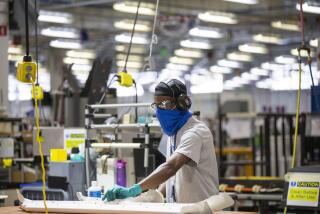Factory Output Increases for 4th Straight Month : Economy: In addition to the 0.5% gain in industrial production, the U.S. trade deficit shrinks to an eight-year low.
- Share via
WASHINGTON — American factories boosted their output in July for the fourth consecutive month, further evidence that the nation’s economy continues to recover from recession, the Federal Reserve reported Friday.
Meanwhile, America’s trade deficit with the rest of the world declined to an eight-year low of $4 billion in June, the Commerce Department said in a separate report, a signal that the recent economic slump is still dampening U.S. consumers’ appetite for imported products.
Economists attached more significance to the strong 0.5% growth in industrial production than to the continuing shrinkage of the trade deficit. The July production increase followed gains of 0.5% in April, 0.8% in May and 0.6% in June--a string of advances that reversed six consecutive months of declining output attributed to the recession.
“The production numbers are more important because they are more current and because over the past year concern has shifted from the trade deficit to the recovery,” said economist Lynn Reaser of First Interstate Bancorp in Los Angeles.
Reaser said the production numbers send a strong signal that the recovery is alive and well, even though initial indicators for July reflected declining employment, especially in services, and slowing consumption, particularly of big-ticket items such as autos.
Economists said the rise in industrial production last month is not necessarily inconsistent with the preliminary July employment figures, which showed a net loss of 51,000 payroll jobs for the month.
In the early phase of an economic recovery, production tends to rise rapidly while employment levels remain relatively unchanged. As a result, productivity often increases dramatically until employers begin hiring more workers to handle the higher production.
The July production report, Reaser said, “suggests the manufacturing sector is beginning to pull out of a sizable and long decline and it may be that for now the service sector may be the major source of weakness in the economy.”
Despite the bullish production figures, some analysts questioned whether the recovery can maintain its momentum. There has been increasing concern that the country could experience a “double-dip” recession, in which the current rebound gives way to another slump.
“The production report was very strong, indicating that a lot of businesses were producing to replenish inventories,” said economist Allen Sinai of Boston Co. “You can see here how quickly production can snap back once there is a rebound. But the worry is whether this is sustainable, given that many indicators, including employment and consumption, have softened.”
According to the Federal Reserve’s production report, factory output advanced at a healthy clip of 0.6% last month, paced by a 10.8% jump in auto production. Even so, overall industrial production remained 2.5% below the level of July, 1990, when the recession began.
And in a lingering reminder of how economic weakness has shrunk vast segments of the economy, the Commerce Department trade report showed that merchandise imports fell sharply to $38.9 billion in June from $40.1 billion the previous month.
The trade report, which is subject to revision, showed U.S. exports slipping to $34.8 billion in June from $35.3 billion in May. But almost all of the decline was accounted for by raw materials, industrial supplies and some chemicals.
Manufacturing exports were a strong $28.2 billion, up $100 million from May and above the $26.8-billion monthly average for the first five months of 1991. Exports of capital goods, powered by aircraft shipments, were up $700 million before seasonal adjustment. Exports of high-technology products, a category in which the United States has maintained a surplus with the rest of the world, rose $800 million to $8.9 billion. The high-tech surplus was $3.6 billion, $600 million above May’s level.
On the import side, many of the declines suggested that wholesalers and retailers were still very cautious about restocking inventories in June, and that manufacturers were careful not to overstock supplies and industrial equipment. Imports of industrial supplies, capital goods and consumer goods were all lower than the month before. This import slowdown is consistent with a slow recovery from recession and helps explain the steady cutback in retail and wholesale jobs over the last few months.
Petroleum imports also were lower, suggesting that inventories built up during the Persian Gulf crisis are still being drawn down. Overall imports of oil and energy products were $4 billion, including 187 million barrels of crude oil, down 7 million from May, at an average cost of $16.39 per barrel, 16 cents below the May average. The overall deficit in traded goods other than oil products shrank to $400 million, down from May’s $900 million non-oil deficit.
Through the first six months of 1991, the trade deficit is running at an annual rate of $60.6 billion, compared to $96.6 billion during the same period last year.
Merchandise Trade Deficit
Billions of dollars, seasonally adjusted; import figures exclude shipping and insurance. June, ‘91: 4.02 May, ‘91: 4.80 June, ‘90: 6.33 Source: Commerce Department
Industrial Production
Seasonally adjusted index, 1987=100 July, ‘91: 107.6 June, ‘91: 107.1 July, ‘90: 110.4 Source: Federal Reserve Board
Capacity Utilization
Seasonally adjusted percent of total capacity July, ‘91: 79.7% June, ‘91: 79.5% June, ‘90: 83.7% Source: Federal Reserve Board
More to Read
Inside the business of entertainment
The Wide Shot brings you news, analysis and insights on everything from streaming wars to production — and what it all means for the future.
You may occasionally receive promotional content from the Los Angeles Times.










